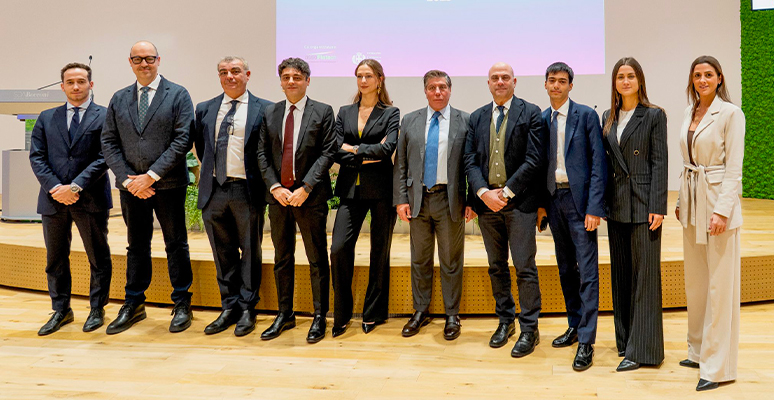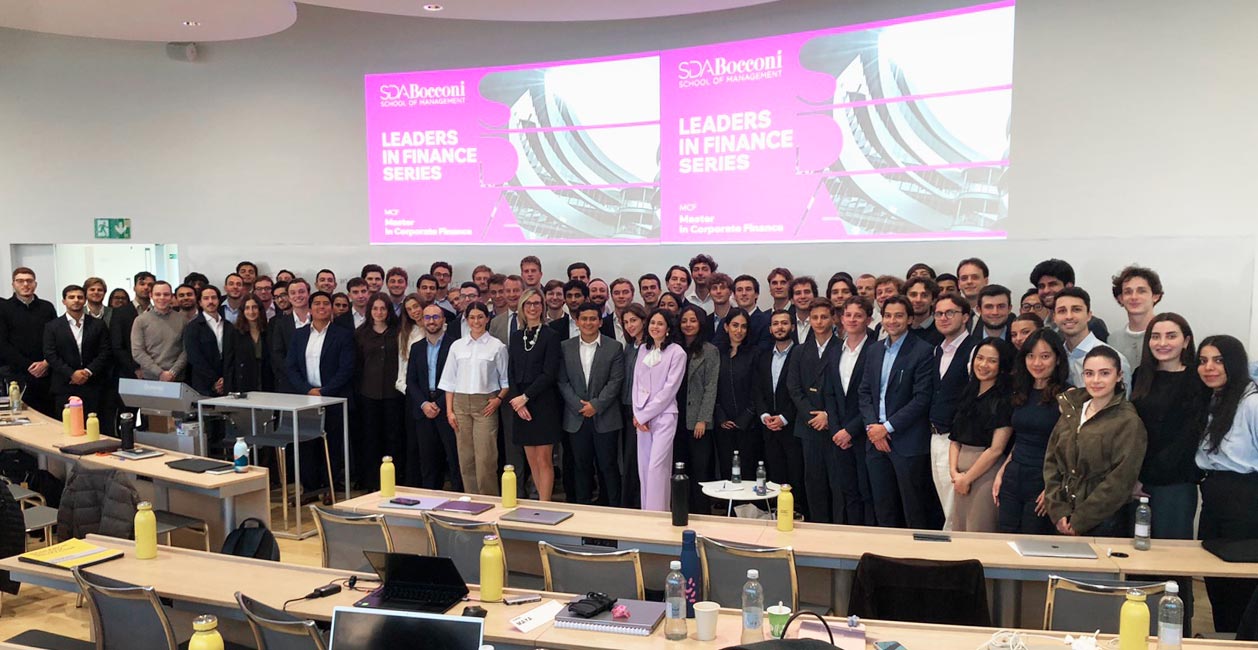
- Start date
- Duration
- Format
- Language
- 3 Dec 2025
- 3 Days
- Class
- Italian
Acquisire competenze su finanziamenti, business plan e valutazione avanzata delle startup per concepire, lanciare e far crescere nuove imprese.
Banking crises can be solved in the collective interest, making everyone stronger in the end than they were before, and turn challenges into opportunities. From this point of view, Italy has one of the most successful cases at international level. The Banco Ambrosiano is a case study that deserves to be studied in depth and can inspire the management of problems today, as explained by Professor Giovanni Bazoli, Chairman Emeritus of Intesa Sanpaolo, to the class of participants of EMF - EMF - Executive Master in Finance, directed by Andrea Beltratti, EMF Academic Director and Alessia Bezzecchi, EMF Program Director at the Opening Ceremony of the EMF 7 Class, who had the privilege of attending the interview in the exclusive location of the Gallerie d'Italia of Intesa Sanpaolo.
The Banco Ambrosiano crisis. On 17 June 1982, Treasury Minister Beniamino Andreatta dissolved the corporate bodies and appointed extraordinary commissioners, as part of a procedure jointly initiated with Bank of Italy Governor Carlo Azeglio Ciampi. The solution to the crisis of Banco Ambrosiano had to be found within the then existing rules, i.e. preserving the separation between the industrial and financial worlds (despite the appetites of industrial capitalism for one of the group's prized assets) and taking into account a further element of difficulty constituted by the presence of the publishing house Rizzoli in the Banco Ambrosiano's ownership portfolio. How could creditors be safeguarded, damage to shareholders be limited, employment levels be maintained, and credit relationships be allowed to continue as part of a systemic intervention that would avoid the loss of the goodwill value of the banking company (while also ensuring the total independence of Corriere della Sera from political appetites)? To understand how difficult the situation was, one must remember that in 1982, interest rates on Italian public debt were 25% (the spread between Italian and German interest rates reached an all-time high of 11.75%) and inflation was at 17%.
The pool of banks. The directors of the systemic operation - Governor Ciampi and Minister Andreatta - received peremptory indications from the liquidators and the Supervisory Committee that recapitalisation of about 1,000 billion lire (over 2 billion euro today, about 0.1% of today's Gross Domestic Product but 0.7% of 1982 GDP) was necessary. They eventually succeeded in involving seven banks, four private and three public, in a rescue project. Some of these, however, were driven - as it turned out in the process - by diverging interests, i.e. the aim of dividing up the most valuable parts of the group. The agreement that was reached envisaged the liquidation of Banco Ambrosiano and the purchase of the passive and active items located in Italy (with the exclusion of the foreign items belonging to the Banco Ambrosiano Holding in Luxembourg) by the new company, made up of the seven banks. This was the first challenge facing the new bank and its chairman: to save and relaunch the company, preserving its unity and autonomy, against the looming risk of a 'break-up'.
A difficult choice. The Academic Director of EMF asks Professor Bazoli how the decision to accept the request to become president of the Nuovo Banca Ambrosiano came about. "Honestly, in a troubled way," the Professor replies. "I had certainly started planning to become a banker. There were two considerations that led me to positively dissolve my reservations after just 48 hours. The first was what I defined in my first speech as president as the civic duty of not shirking a commitment that was authoritatively asked of me (by people of the highest level such as Ciampi and Andreatta) for a just cause of great general interest. The second, however, was also a certain taste for challenge. I understood the enormous difficulties I would have to face in the assignment, but at the same time I will not hide the fact that the unexpected and risky adventure attracted me, not least because of the professional experience I would have gained by moving into a different field from the one for which I had prepared myself'.
Shareholders, depositors, employees. "What were the main actions taken at Nuovo Banco Ambrosiano?" "In full agreement with the general manager, Pierdomenico Gallo, the immediate objective was the rescue of the corporate structure. The interest of all relevant stakeholders was kept in mind. The value of the deposits was safeguarded. No employees lost their jobs, thanks to the relocation of some of the Bank's staff to the seven banks in the rescue consortium and, above all, thanks to a rapid industrial relaunch that allowed employment levels to be maintained. But I would also like to add that it was also of extraordinary significance and importance that, despite the wiping out of the value of the shares, the shareholders of the Bank were not forgotten, but were in some way compensated through the free allocation of warrants convertible into shares of the new banking entity'. "Were these extraordinary results achieved with the agreement of all parties? "Some steps were very critical precisely because of the diversity of the rescue team. I had to devote a lot of energy to convince all participants to respect the design of a comprehensive and unified relaunch. This was within the New Bank structure. But it was mainly from the outside that dialectic relationships developed - sometimes collaborative, sometimes conflictual - with the country's leading economic figures, such as Gianni Agnelli and Enrico Cuccia. But mutual respect and esteem have always prevailed'.
Lessons from the case study. "What are the main lessons we can learn from this fascinating case study?" "There are many. A first lesson is that rules, in my opinion, must be interpreted on a case-by-case basis and never applied automatically. For example, having protected, as much as possible, the interests of the old shareholders turned out to be not only the right decision, but also a functional one for the relaunch project of the new company. A second lesson is the decisive importance of correct interpretation of corporate governance and the legitimate expectations of all stakeholders, over and above the prevailing rules. A third lesson relates to ethics, as I would argue that a vision that is attentive to combining the corporate interest with the collective interest favours the safest and most fruitful choices'. "A further lesson," adds the Academic Director of the Executive Master in Finance, "relates to leadership: to interpret the rules in such a complex situation, it is essential to possess a strong sense of leadership, which induces the many stakeholders to make shared decisions that overcome particular visions. This is what Professor Bazoli did as chairman of Nuovo Banco Ambrosiano: he showed everyone that in extraordinarily difficult situations it is possible to be a leader and show the way'.
Advice for Executive Master in Finance participants. "What advice would you like to give our participants?" "First and foremost, it is crucial to learn how to evaluate people, employees and competitors as objectively as possible, because even in business one cannot disregard personal relationships. Secondly, one must not be afraid of the abilities and skills of others. Indeed, it is better to find oneself working with people who are prepared and capable, even if dissenting, than with people who are agreeable but of little depth. In the end, it must also be considered that the responsibility for choices is always and exclusively personal. I have never taken an important decision without having acquired several opinions, but at the final moment of the decision there is no escape: you are alone. Alone with one's conscience'.
SDA Bocconi School of Management

Acquisire competenze su finanziamenti, business plan e valutazione avanzata delle startup per concepire, lanciare e far crescere nuove imprese.

Il corso intende fornire tutte le competenze necessarie a padroneggiare e applicare i principali strumenti e framework esistenti in materia di sustainability reporting.

Comprendere e gestire le variabili rilevanti negli investimenti immobiliari come convenienza economica e strutturazione del finanziamento bancario dei progetti.

